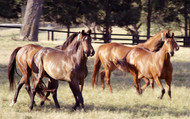Preparing Your Dry Mare This Breeding Season
Posted by Scone Equine Hospital on 2nd Apr 2019
Breeding your broodmare is a big decision. There are so many things to consider… stallion choices, reproductive options, veterinary costs and so much more! The ultimate goal is to have a healthy foal, so how do we achieve this? Have a look at a few tips below for preparing your dry mare for the upcoming breeding season.
1. Good Health is vital. Before starting on any breeding journey, it is important to make sure your mare’s general health is as good as it can be. Arrange for all routine care to be done before starting the breeding process. This would include yearly vaccinations, a dental check-up and deworming. Remember, what’s good for the mare is good for the foal!
2. Weigh it up. In the lead up to the breeding season, assess your mares body weight. It is important that your mare is in good body condition for breeding. Most importantly, she should not be too heavy. Mares who carry excess weight may have trouble cycling and falling pregnant. Ideally, the mares should initially be in light condition, with a body score of 2.5/5. This allows you to have the mare on a rising plane of nutrition and gradually improving her condition whilst she is getting ready to be bred.
3. Lights, Rugs, Action. Breeding earlier in the breeding season usually gives us the best results. Some mares will benefit from being rugged, put under lights, or the use of an Equilume mask to assist them to start cycling. If planning to breed early in the season, speak with your veterinarian for the best course of action for your mare.
4. Make a plan. Prior to the breeding season, or when your mare starts cycling, it is recommended that they have a breeding soundness evaluation performed by your veterinarian. This would include an ultrasound examination of the reproductive tract, a speculum or manual examination of the vagina and cervix and swabs taken from the uterus and clitoris for culture. This allows abnormalities to be identified at the beginning of the breeding season and addressed before the first breeding of the mare. If you have not noticed that your mare is cycling before the end of September, it is important that the mare has an examination to ensure there are not any obvious reasons for the mare not coming into season such as an unexpected pregnancy! Furthermore, not all mares are obvious when displaying signs of being in season or “oestrous behaviour”. Your veterinarian should be able to determine the stage of her cycle by an ultrasound examination of her uterus and ovaries.
5. Stallion time. Whether your mare is having a Live Cover, or being bred by Artificial Insemination, make sure you have a solid plan in place and have discussed arrangements before lining her up for cover. Good communication between mare owner and stallion farm will ensure that your mare is given the best opportunity to conceive.
It always pays to have a good plan in place in order to have the most successful outcome with your mare. When it comes to breeding, careful planning with your veterinarian, along with taking precautions such as a breeding soundness exam and swabs prior to breeding, will always assist with the best possible opportunity to conceive and have a live, healthy foal next year.

